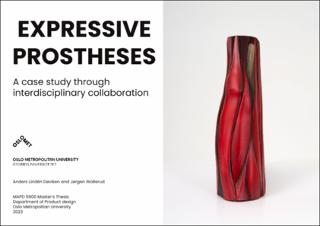| dc.description.abstract | In the field of prosthetics, the main focus is usually to bring back functionality after limb loss or congenital limb deficiency. Prosthetics can be categorized in many different ways. There are bodily powered rudimentary claws, myoelectric prostheses, and advanced bionic hands that are the most advanced prosthesis available. One of the most common types are myoelectric prostheses, with a silicone rubber glove on the outside, supposed to look like human skin. These prostheses are made to mimic the visual expression of real limbs, but still very often they have an unnatural look. The colors are not perfect, and the mechanical movements are unnatural. The users are of all ages, from children to old people, and the prostheses are technically and physically adapted to every user’s needs. But these prostheses lack possibilities for the user to express themselves through the prosthesis. Every human is unique, and we express ourselves in many ways, through clothes, hairstyle, glasses, the way we act, etc. These are all choices that reflect who we are. Glasses have evolved from being seeing aids, into fashion pieces in the wardrobe (Pullin, 2009). Can this evolution be translated to prosthetics? Our thesis takes an approach to this issue, by incorporating co-creation with users of prosthetics, orthopedic engineers and designers to create a truly unique and expressive product. Relevant literature, semi-structured interviews and other research methods were utilized to gather a foundation of insights that we used in the case study with the subject “Erik”, to design a prosthesis he would want to use in his everyday life. The findings suggest that including the user in the design process with a team of designers and orthopedic engineers, could lead to higher satisfaction with the aesthetic expression. As this project will continue after the end of this project, it is important to acknowledge that more research is necessary to understand all aspects of an expressive prosthesis, as well as how it should be integrated in the process for the workshops responsible. This thesis will explore the field of expressive prosthetics, its potential value in our society, and how it can be implemented in the orthopedic system through transdisciplinary collaboration. | en_US |
